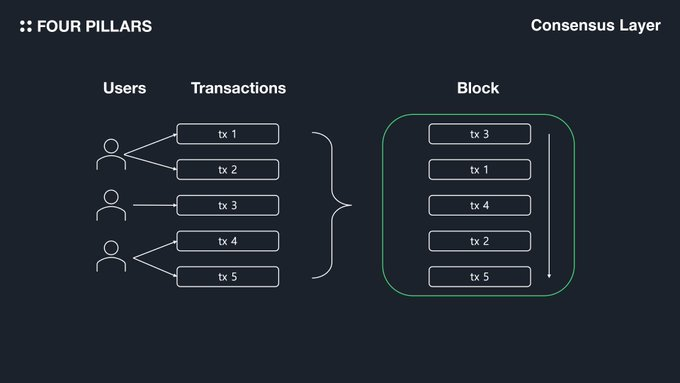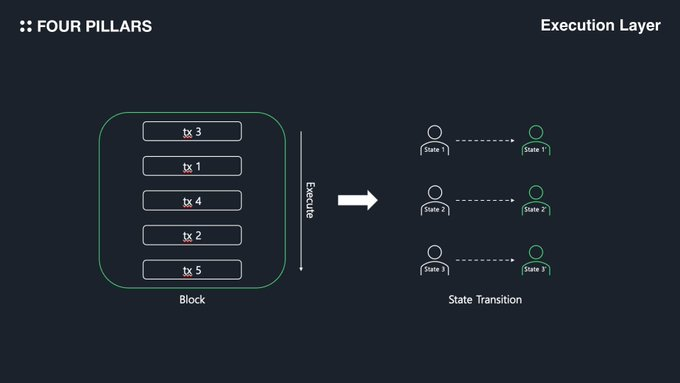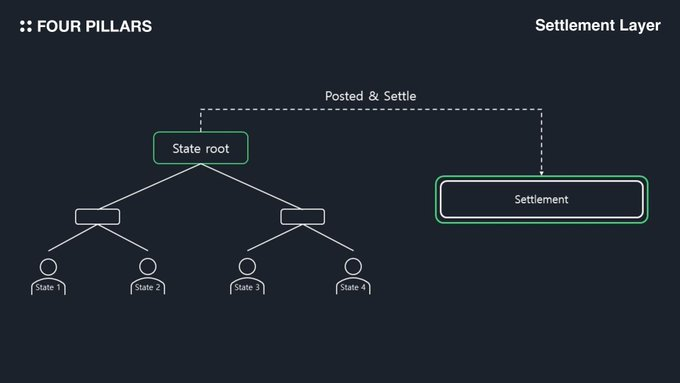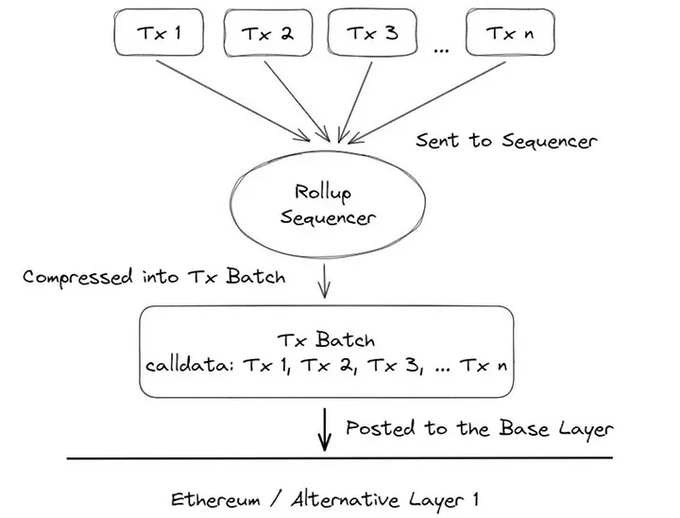[Blockchain’s Four Core Functions and L2] – by nananaa.eth
Because @EspressoSys is a project built for L2,
many people have told me they struggle with the basic concepts and terminology.
To help you grasp Espresso’s core ideas and to set the stage for the articles I’ll write later I’ve put together this primer.
Since it covers fundamental blockchain concepts, it should also help you when learning about other projects.
In this series we’ll cover three big topics:
(1) The four core functions of a blockchain: Execution, Consensus, Settlement, DA
(2) Ethereum L2
(3) L2 Sequencer & Confirmation
First I’ll review the four blockchain functions to build a solid foundation.
Next, I’ll introduce Ethereum L2.
Finally, I’ll explain the two concepts Espresso focuses on: the L2 Sequencer and Confirmation.
[1. The Four Core Functions of a Blockchain]
A blockchain is a state transition machine: it collects our transactions in blocks,
then executes them in order to update each account’s state.
For example, if I swap 1 ETH for 0.1 BTC,
once that transaction lands in a block and is executed,
my account state changes to lose 1 ETH and gain 0.1 BTC.
What must happen behind the scenes to make that work?
(1) Consensus: We need to decide the order in which transactions go into each block.
(2) Execution: We need to execute those agreed-upon transactions, in order, to update account states.
(3) Settlement: We need to finalize those state changes so that everyone can trust “yes, you really did receive 0.1 BTC.”
(4) Data Availability (DA): Because blockchains are trustless, any node must be able to re-execute transactions in a block to independently verify them,
so the transactions themselves must be stored in an available layer.
In short, a functioning blockchain must perform Consensus / Execution / Settlement / DA.
Quick Recap of Each Function
- Consensus: Deciding the order of transactions included in a block
- Execution: Running those transactions in order and updating state
- Settlement: Guaranteeing the finality of the updated state (for example, by waiting a certain number of blocks or employing another finality mechanism)
- Data Availability: Making the transactions in each block available so anyone can replay and verify them
[2. What Is an Ethereum L2?]
We just saw the four core functions of blockchains.
When one chain handles all four itself, we call it a monolithic blockchain.
When we split them across separate layers, we call it a modular blockchain.
An Ethereum L2 is a modular chain that uses Ethereum as its Settlement layer.
It leverages Ethereum’s security to finalize state changes,
while pushing the other functions Consensus, Execution, DA) onto separate, more efficient layers.
Among Ethereum L2’s, the two most common patterns are Rollup and Validium:
Rollup
A Rollup uses Ethereum for both DA and Settlement.
Consensus: usually a centralized sequencer,
though it can use a decentralized sequencer (e.g. via Espresso),
or rely on Ethereum validators in a “Based Rollup”
Execution: often an EVM, but could be another VM (e.g. StarkNet’s Cairo VM)
Settlement: Ethereum
DA: Ethereum
Examples you know: @arbitrum, @Optimism, etc.
Validium
A Validium is just like a Rollup except it uses an external DA layer instead of Ethereum.
If Some Validium use Espresso DA, we can say those as Espresso Validium.
Consensus: centralized or decentralized sequencer
Execution: EVM or altVM
Settlement: Ethereum
DA: altDA (e.g. Celestia, Espresso DA, etc.)
For instance, for the @EclipseFND which is planning to have a TGE soon is using:
Consensus: Centralized sequencer
Execution: SVM
DA: Celestia
Settlement: Ethereum
[3. L2 Sequencer & Confirmation]
So far, we’ve reviewed the fundamental concepts of blockchain and Ethereum L2.
Lastly, let’s dive into the L2 Sequencer and Confirmation, which are key focuses for Espresso.
L2 Sequencer
The L2 Sequencer is the entity which makes the blocks which means
(1) orders and executes transactions on L2
(2) publishes the list of transactions and resulting state root onto Ethereum.
Most L2s today run a single, centralized sequencer that orders incoming transactions, executes them, and then reports the new state to users.
But can have a single point failure. Arbitrum’s sequencer has paused before, for example.
A decentralized sequencer solves this.
Espresso provides an decentralized L2 sequencer module powered by HotShot (a high-performance BFT consensus algorithm).
If an L2 uses Espresso’s sequencer, then for each block a Leader Node chosen by Espresso’s consensus will order and execute transactions.
Confirmation
A Confirmation guarantees to the user that a state change is final.
On L2, however, sequencer cannot provide full confirmation until Ethereum settlement completes.
What most L2 sequencers show you is a pre-confirmation basically a promise:
“We’ll publish your state change on Ethereum for final settlement.”
Because it’s only a pre-confirmation, if something goes wrong during Ethereum settlement, that change could be rolled back (i.e., reorg).
That’s why exchanges tell you to “wait for confirmations” after depositing your funds from Arbitrum or Optimism
they’re waiting until Ethereum finality eliminates any reorg risk.
Espresso’s HotShot consensus lets you offer stronger, faster confirmations on L2
stronger than simple sequencer pre-confirmations, though still not as absolute as waiting for Ethereum itself.
I’ll dive deeper into Espresso confirmations in a future article.
Summary
Four Core Blockchain Functions
- A blockchain performs Consensus, Execution, Settlement, DA
- Consensus: decide transaction order
- Execution: run transactions to update state
- Settlement: finalize state changes
- DA: ensure transactions remain available for replay and verification
Ethereum L2
- Ethereum L2s using Ethereum for Settlement
- Rollup: uses Ethereum for DA + Settlement
- Validium: uses external DA + Ethereum Settlement
L2 Sequencer & Confirmation
- The Sequencer orders and executes L2 transactions and publishes state roots
- Sequencer outputs are pre-confirmations, which can roll back until Ethereum settlement
- Espresso’s HotShot enables decentralized sequencing and stronger, rapid confirmations
I hope this primer clarifies basic blockchain principles, Ethereum L2, and the roles of Sequencer & Confirmation so you’ll be ready for the deep dive into Espresso itself!




2.72K
14
The content on this page is provided by third parties. Unless otherwise stated, OKX TR is not the author of the cited article(s) and does not claim any copyright in the materials. The content is provided for informational purposes only and does not represent the views of OKX TR. It is not intended to be an endorsement of any kind and should not be considered investment advice or a solicitation to buy or sell digital assets. To the extent generative AI is utilized to provide summaries or other information, such AI generated content may be inaccurate or inconsistent. Please read the linked article for more details and information. OKX TR is not responsible for content hosted on third party sites. Digital asset holdings, including stablecoins and NFTs, involve a high degree of risk and can fluctuate greatly. You should carefully consider whether trading or holding digital assets is suitable for you in light of your financial condition.

